高中英语复习-非谓语动词与独立主格结构(含答案)
高考英语总复习--非谓语动词含解析
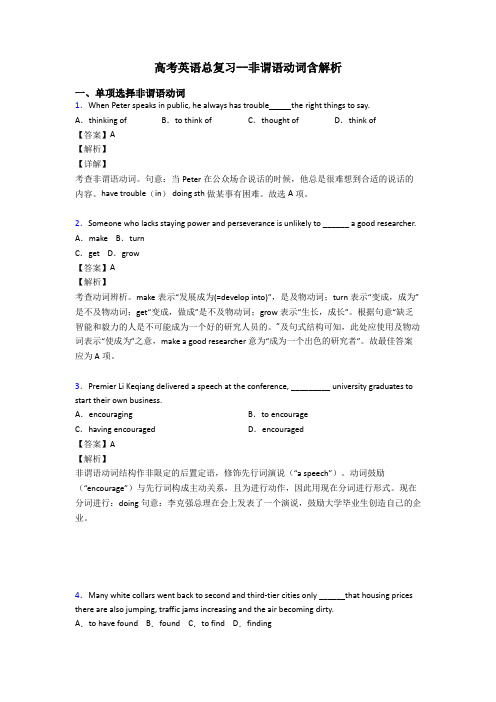
高考英语总复习--非谓语动词含解析一、单项选择非谓语动词1.When Peter speaks in public, he always has trouble _ the right things to say. A.thinking of B.to think of C.thought of D.think of【答案】A【解析】【详解】考查非谓语动词。
句意:当Peter在公众场合说话的时候,他总是很难想到合适的说话的内容。
have trouble(in) doing sth 做某事有困难。
故选A项。
2.Someone who lacks staying power and perseverance is unlikely to ______ a good researcher. A.make B.turnC.get D.grow【答案】A【解析】考查动词辨析。
make表示“发展成为(=develop into)”,是及物动词;turn表示“变成,成为”是不及物动词;get“变成,做成”是不及物动词;grow表示“生长,成长”。
根据句意“缺乏智能和毅力的人是不可能成为一个好的研究人员的。
”及句式结构可知,此处应使用及物动词表示“使成为”之意,make a good researcher 意为“成为一个出色的研究者”。
故最佳答案应为A项。
3.Premier Li Keqiang delivered a speech at the conference, _________ university graduates to start their own business.A.encouraging B.to encourageC.having encouraged D.encouraged【答案】A【解析】非谓语动词结构作非限定的后置定语,修饰先行词演说(“a speech”)。
动词鼓励(“encourage”)与先行词构成主动关系,且为进行动作,因此用现在分词进行形式。
【英语】高一英语非谓语动词试题(有答案和解析)及解析
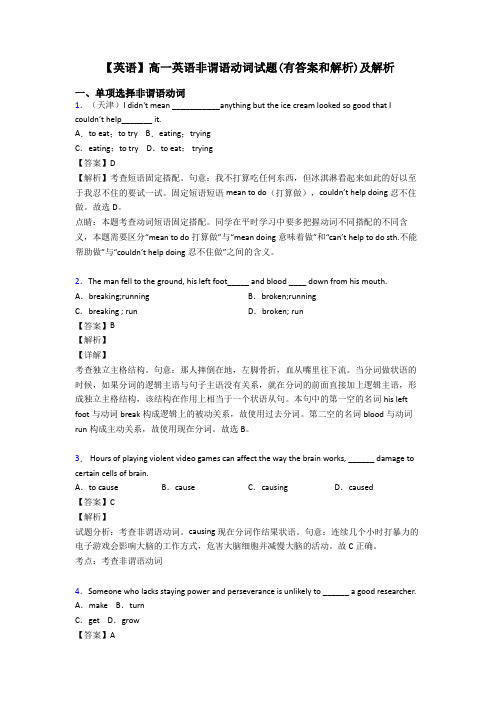
【英语】高一英语非谓语动词试题(有答案和解析)及解析一、单项选择非谓语动词1.(天津)I didn't mean ___________anything but the ice cream looked so good that I couldn’t help_______ it.A.to eat;to try B.eating;tryingC.eating;to try D.to eat; trying【答案】D【解析】考查短语固定搭配。
句意:我不打算吃任何东西,但冰淇淋看起来如此的好以至于我忍不住的要试一试。
固定短语短语mean to do(打算做),couldn’t help doing忍不住做。
故选D。
点睛:本题考查动词短语固定搭配。
同学在平时学习中要多把握动词不同搭配的不同含义,本题需要区分“mean to do打算做”与“mean doing意味着做”和“can’t help to do sth.不能帮助做”与“couldn’t help doing忍不住做”之间的含义。
2.The man fell to the ground, his left foot_____ and blood ____ down from his mouth. A.breaking;running B.broken;runningC.breaking ; run D.broken; run【答案】B【解析】【详解】考查独立主格结构。
句意:那人摔倒在地,左脚骨折,血从嘴里往下流。
当分词做状语的时候,如果分词的逻辑主语与句子主语没有关系,就在分词的前面直接加上逻辑主语,形成独立主格结构,该结构在作用上相当于一个状语从句。
本句中的第一空的名词his left foot与动词break构成逻辑上的被动关系,故使用过去分词。
第二空的名词blood与动词run构成主动关系,故使用现在分词。
故选B。
3. Hours of playing violent video games can affect the way the brain works, ______ damage to certain cells of brain.A.to cause B.cause C.causing D.caused【答案】C【解析】试题分析:考查非谓语动词。
高三英语非谓语动词和独立主格结构
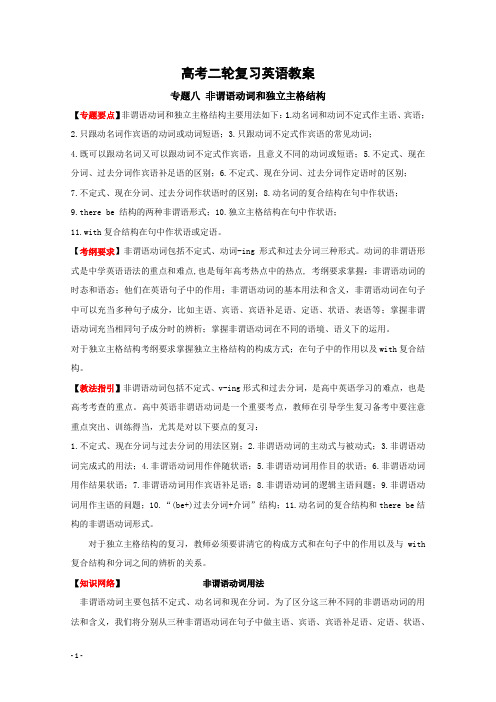
高考二轮复习英语教案专题八非谓语动词和独立主格结构【专题要点】非谓语动词和独立主格结构主要用法如下:1.动名词和动词不定式作主语、宾语;2.只跟动名词作宾语的动词或动词短语;3.只跟动词不定式作宾语的常见动词;4.既可以跟动名词又可以跟动词不定式作宾语,且意义不同的动词或短语;5.不定式、现在分词、过去分词作宾语补足语的区别;6.不定式、现在分词、过去分词作定语时的区别;7.不定式、现在分词、过去分词作状语时的区别;8.动名词的复合结构在句中作状语;9.there be 结构的两种非谓语形式;10.独立主格结构在句中作状语;11.with复合结构在句中作状语或定语。
【考纲要求】非谓语动词包括不定式、动词-ing形式和过去分词三种形式。
动词的非谓语形式是中学英语语法的重点和难点,也是每年高考热点中的热点, 考纲要求掌握:非谓语动词的时态和语态;他们在英语句子中的作用;非谓语动词的基本用法和含义,非谓语动词在句子中可以充当多种句子成分,比如主语、宾语、宾语补足语、定语、状语、表语等;掌握非谓语动词充当相同句子成分时的辨析;掌握非谓语动词在不同的语境、语义下的运用。
对于独立主格结构考纲要求掌握独立主格结构的构成方式;在句子中的作用以及with复合结构。
【教法指引】非谓语动词包括不定式、v-ing形式和过去分词,是高中英语学习的难点,也是高考考查的重点。
高中英语非谓语动词是一个重要考点,教师在引导学生复习备考中要注意重点突出、训练得当,尤其是对以下要点的复习:1.不定式、现在分词与过去分词的用法区别;2.非谓语动词的主动式与被动式;3.非谓语动词完成式的用法;4.非谓语动词用作伴随状语;5.非谓语动词用作目的状语;6.非谓语动词用作结果状语;7.非谓语动词用作宾语补足语;8.非谓语动词的逻辑主语问题;9.非谓语动词用作主语的问题;10.“(be+)过去分词+介词”结构;11.动名词的复合结构和there be结构的非谓语动词形式。
高考英语备考策略 独立主格结构的讲解与训练-人教版高三全册英语试题
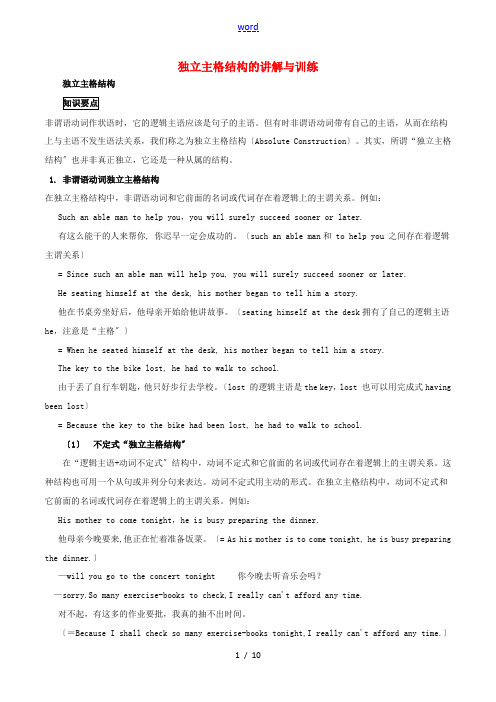
独立主格结构的讲解与训练独立主格结构非谓语动词作状语时,它的逻辑主语应该是句子的主语。
但有时非谓语动词带有自己的主语,从而在结构上与主语不发生语法关系,我们称之为独立主格结构〔Absolute Construction〕。
其实,所谓“独立主格结构〞也并非真正独立,它还是一种从属的结构。
1. 非谓语动词独立主格结构在独立主格结构中,非谓语动词和它前面的名词或代词存在着逻辑上的主谓关系。
例如: Such an able man to help you,you will surely succeed sooner or later.有这么能干的人来帮你, 你迟早一定会成功的。
〔such an able man和 to help you 之间存在着逻辑主谓关系〕= Since such an able man will help you, you will surely succeed sooner or later.He seating himself at the desk, his mother began to tell him a story.他在书桌旁坐好后,他母亲开始给他讲故事。
〔seating himself at the desk拥有了自己的逻辑主语he,注意是“主格〞〕= When he seated himself at the desk, his mother began to tell him a story.The key to the bike lost, he had to walk to school.由于丢了自行车钥匙,他只好步行去学校。
〔lost 的逻辑主语是the key,lost 也可以用完成式having been lost〕= Because the key to the bike had been lost, he had to walk to school.〔1〕不定式“独立主格结构〞在“逻辑主语+动词不定式〞结构中,动词不定式和它前面的名词或代词存在着逻辑上的主谓关系。
高二英语非谓语动词作宾语补足语与独立主格结构的联系单选题30题

高二英语非谓语动词作宾语补足语与独立主格结构的联系单选题30题1.The teacher made us ______ our homework on time.A.finishB.to finishC.finishingD.finished答案:A。
本题考查make sb do sth 的用法,make 后面接不带to 的不定式作宾语补足语。
B 选项to finish 错误;C 选项finishing 是现在分词形式,不能作make 的宾语补足语;D 选项finished 是过去分词形式,也不符合make 的用法。
2.We saw the students ______ basketball on the playground.A.playB.to playC.playingD.played答案:C。
see sb doing sth 表示看到某人正在做某事;see sb do sth 表示看到某人做某事的全过程。
本题强调看到学生正在打篮球,所以用playing。
A 选项play 不能表示正在进行的动作;B 选项to play 不符合see 的用法;D 选项played 是过去分词形式,也不正确。
3.The boss had his workers ______ overtime every day.A.workB.to workC.workingD.worked答案:C。
have sb doing sth 表示让某人一直做某事;have sb do sth 表示让某人做某事。
本题强调工人每天都加班,是持续的动作,所以用working。
A 选项work 没有体现出持续的状态;B 选项to work 不符合have 的用法;D 选项worked 是过去分词形式,也不恰当。
4.I heard him ______ a beautiful song last night.A.singB.to singC.singingD.sung答案:A。
高中英语 独立主格结构精讲(配套练习和答案)
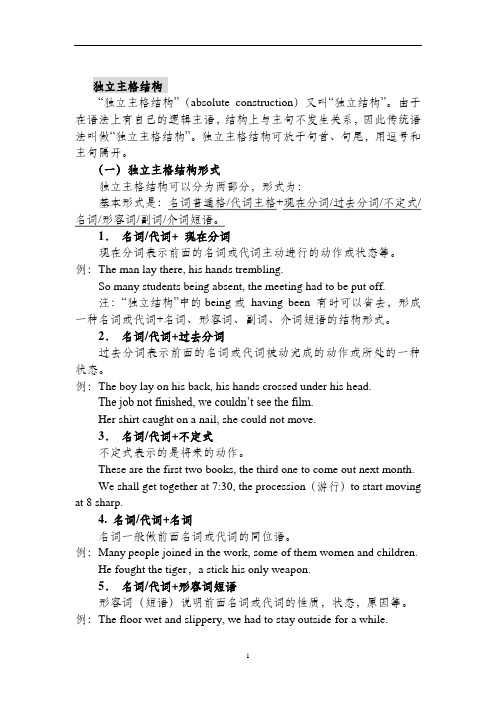
独立主格结构“独立主格结构”(absolute construction)又叫“独立结构”。
由于在语法上有自己的逻辑主语,结构上与主句不发生关系,因此传统语法叫做“独立主格结构”。
独立主格结构可放于句首、句尾,用逗号和主句隔开。
(一)独立主格结构形式独立主格结构可以分为两部分,形式为:基本形式是:名词普通格/代词主格+现在分词/过去分词/不定式/名词/形容词/副词/介词短语。
1.名词/代词+ 现在分词现在分词表示前面的名词或代词主动进行的动作或状态等。
例:The man lay there, his hands trembling.So many students being absent, the meeting had to be put off.注:“独立结构”中的being或having been 有时可以省去,形成一种名词或代词+名词、形容词、副词、介词短语的结构形式。
2.名词/代词+过去分词过去分词表示前面的名词或代词被动完成的动作或所处的一种状态。
例:The boy lay on his back, his hands crossed under his head.The job not finished, we couldn’t see the film.Her shirt caught on a nail, she could not move.3.名词/代词+不定式不定式表示的是将来的动作。
These are the first two books, the third one to come out next month.We shall get together at 7:30, the procession(游行)to start moving at 8 sharp.4. 名词/代词+名词名词一般做前面名词或代词的同位语。
例:Many people joined in the work, some of them women and children.He fought the tiger,a stick his only weapon.5.名词/代词+形容词短语形容词(短语)说明前面名词或代词的性质,状态,原因等。
【英语】高三英语非谓语动词试题(有答案和解析)及解析
【英语】高三英语非谓语动词试题(有答案和解析)及解析一、单项选择非谓语动词1.________ by the advances in technology, many farmers have set up wind farms on their land. A.Being encouraged B.EncouragingC.Encouraged D.Having encouraged【答案】C【解析】试题分析:考查过去分词做状语:句意:被科技的进步鼓舞着,很多农民在自己的土地上建起了风力发电厂。
逗号前面的是非谓语动词做状语,encourage和这句话的主语many farmers是被动关系,用过去分词做状语,选C。
考点:考查过去分词做状语2._______ the classroom for a whole afternoon, the monitor decided to have a rest. A.Having cleaned B.To cleanC.Cleaned D.Clean【答案】A【解析】考查非谓语动词。
句意:整个下午打扫了教室之后,班长决定休息一下。
句中clean的动作比decided早,故用完成时;the monitor和clean是主动关系,此处作状语用动词-ing形式,故此处用动词-ing形式的完成时,故选A。
3.When he was a boy, he used to go there and watch _____.A.to repair bicycles B.bicycles to be repairedC.bicycles being repaired D.repairing bicycles【答案】C【解析】4.(北京)The national park has a large collection of wildlife, _________ from butterflies to elephants.A.ranging B.rangeC.to range D.ranged【答案】A【解析】试题分析:句意:国家公园有许多的野生动物,包括从蝴蝶到大象等等。
高中英语非谓语动词试题(有答案和解析)及解析
【解析】
【详解】
考查现在分词。句意:听见这个消息,她冲了出去,留在书本打开着放在桌子上,就消失在远处了。第一空leave与she构成主动关系,使用现在分词的形式。第二空the book与lie构成主动关系,还是使用现在分词的形式,open是形容词表示状态,lying open是宾语补足语,对the book进行补充说明。故D选项正确。
A.to takeB.to be taken
C.takingD.being taken
【答案】D
【解析】
【详解】
考查非谓语动词。句意:我仍旧记得被带去法门寺和在那里看到的。remember to do sth.“记得要做某事(该动作未发生)”;remember doing sth.“记得做过某事(该动作已经发生)”。依据后文的“what I saw there”可知这里说的是记得已经发生的动作;再者take的宾语就是句子的主语,二者之间是动宾关系,应用被动形式,所以选being taken。故选D。
高中英语非谓语动词试题(有答案和解析)及解析
一、单项选择非谓语动词
1.________ the convenience of digital payment, many senior citizens started to use smart phones.
A.To enjoyB.EnjoyingC.To have enjoyedD.Enjoy
考点:考查时态。
14.______in painting, John didn’t notice evening approaching.
A.To absorbB.To be absorbed
C.AbsorbedD.Absorbing
(完整版)非谓语动词和独立主格
非谓语动词非谓语动词:1.动词不定式【to+动词原型】2.动名词【动词+ing】3.(现在、过去)分词四个要点:1.一个句子中有多个动词时,其中一个是谓语,其他全部是非谓语。
2.主动ing,被动ed,要做去做todo3.如果非谓语是主语做的,前面什么都不用加;如果非谓语不是主语做的,谁做的,加谁。
4.非谓语就是从句的简化。
举例:Jack唱着歌回家。
Singing a song,Jack went homeJack受伤了回家。
Injured,Jack went homeRose受伤了,Jack哭了。
Rose injured,Jack criedRose笑了,Jack笑了。
Rose smiling,Jack smiled.独立主格结构独立主格结构就是给非谓语动词加上逻辑主语独立主格结构基本构成形式:名词(代词)+现在分词;过去分词;形容词;副词;不定式;名词;介词短语)独立主格结构的特点:1)独立主格结构的逻辑主语与句子的主语不同,它独立存在。
2)名词或代词与后面的分词,形容词,副词,不定式,介词等是主谓关系。
3)独立主格结构一般有逗号与主句分开。
这种结构与主句不发生句法上的联系,它的位置相当灵活,可置于主句前、主句末或主句中,常由逗号将其与主句分开。
在句中作状语,相当于一个状语从句。
需特别注意的是,独立主格结构与主句之间不能使用任何连接词。
这里分形式具体举例,以便熟悉知识点。
1.名词(代词)+现在分词Time permitting, I will go with you时间允许的话,我就和你一起走。
2.名词(代词)+过去分词The work done, he went back home.工作完成后,他回家了。
3.名词(代词)+不定式在“名词/代词+动词不定式”结构中,动词不定式和它前面的名词或代词如果存在着逻辑上的主谓关系,动词不定式则用主动的形式;如果是动宾关系,则用被动形式。
Many trees, flowers, and grass to be planted, our school will look even more beautiful.种上许多的树、花和草后,我们新建的学校看上去将更美。
高考英语 语法专题复习讲义独立主格结构
落堕市安心阳光实验学校高考英语语法专题复习经典讲义主格结构(一):主格的概念“主格结构”是由名词或代词作为逻辑主语,加上分词、形容词、副词、动词不定式或介词短语作为逻辑谓语构成。
这种结构在形式上与主句没有关系,通常称为“主格结构”。
(二):主格的功能“主格结构”实质就是带有自己主语的非限制性状语从句。
众所周知非限制性从句通常以主句的某一成分作为自己的逻辑主语,从而依附于主句。
而有些非限制性从句和无动词从句带有自己的主语,在结构上与主句不发生关系,因此成为主格结构。
其实,虽然叫做主格结构,并不是真正的,它还是一种从属分句,在句中有多种作用。
如:表原因、表条件、表方式、表伴随、表时间等,在句中通常起状语作用。
主格结构主要用于描绘性文字中,其作用相当于一个状语从句,常用来表示时间、原因、条件、行为方式或伴随情况等。
例如:1) 表示时间The meeting being over, all of us went home. 开完会后我们都回家了。
Her work done, she sat down for a cup of tea. 她干完了活,坐下来喝茶。
2)表示条件The condition being favorable, he may succeed. 若条件有利,他或许能成功。
3)表示原因There being no taxis, we had to walk. 没有出租车,我们只好步行。
He wrapped her up with great care, the night being dark and frosty. 夜又黑又冷,所以他把她裹得严严实实的。
4)表示伴随情况Almost all metals are good conductors, silver being the best of all. 几乎所有的金属都是良导体,而银则是最好的导体。
(=Almost all metals are good conductors,and silver is the best of all.)(三):主格结构的构成:名词(代词)+现在分词、过去分词;名词(代词)+形容词;名词(代词)+副词;名词(代词)+名词名词(代词)+不定式;名词(代词) +介词短语构成。
- 1、下载文档前请自行甄别文档内容的完整性,平台不提供额外的编辑、内容补充、找答案等附加服务。
- 2、"仅部分预览"的文档,不可在线预览部分如存在完整性等问题,可反馈申请退款(可完整预览的文档不适用该条件!)。
- 3、如文档侵犯您的权益,请联系客服反馈,我们会尽快为您处理(人工客服工作时间:9:00-18:30)。
非谓语动词与独立主格结构非谓语动词分为三类:不定式(infinitive)、动名词(gerund)和分词(participle)。
其特点是:1.不定式、动名词和分词可以做很多句子成分,但就是不能单独做谓语,这也是它们被称为"非谓语动词"的原因。
2.它们具有各种形态:一般式、主动态、被动态、进行态和完成态。
3.不定式和动名词可以做主语、宾语、表语、补语等。
但不管起什么作用,它们都具有动词的功能,但无语法上的动词性质,这一点可以通过它们不受主语的人称和数的限制体现出来。
4.分词起形容词和副词作用,可做表语、定语、状语,但不能做主语和宾语。
它也不受主语人称和数的限制。
一.不定式1.完成式不定式的一般形式所表示的动作, 通常与主要谓语表示的动作(状态)同时(或几乎同时)发生, 或是在它之后发生. 假如不定式所表示的动作, 在谓语所表示的动作(状态)之前发生, 就要用不定式的完成式.I am glad to have seen your mother (= I am glad I have seen your mother).(比较: I am glad to see you.)He is said to have written a new book about workers.He pretended not to have seen me.2.进行式如果主要谓语表示的动作(状态)发生时, 不定式表示的动作正在进行, 这时要用不定式的进行式.You are not supposed to be working. You haven’t quite recovered yet.We didn’t expect you to be waiting for us here.He pretended to be listening attentively.3.完成进行式在谓语所表示的时间之前一直进行的动作, 就要用不定式的完成进行式.The struggle was known to have been going for twenty years.We are happy to have been working with you.4.被动式当不定式的逻辑上的主语是不定式所表示的动作的承受者时, 不定式一般要用被动形式.It is an honor for me to be asked to speak here.She hated to be flattered.He wanted the letter to be typed at once.【例】Sir Denis, who is 78, has made it known that much of his collection ______ to the nation.A) has left B) is to leave C) leaves D) is to be left结合选项来看,全句的意思:“78岁的丹尼斯爵士已经向众人宣布他的许多收藏品将留给国家"。
收藏品是"被留给国家”,因此需要一个被动式做宾语,所以答案是D) is to be left。
(二)句法功能1.不定式作主语【例】It is not unusual for workers in that region _________.A) to be paid more than a month later B) to be paid later than more a monthC) to pay later than a month more D) to pay later more than a monthit 在句中作形式主语。
而不定式to be paid more than a month是句子的逻辑主语。
结合选项全句的意思是:“那个地方的工人一个多月后才得到工资是常有的事”,答案是A)。
2.不定式做宾语大部分动词可加不定式做宾语。
如:We are planning to build a reservoir here.【例】There is a man at the reception desk who seems very angry and I think he means _________ trouble.A) making B) to make C) to have made D) having made动词mean在本句中的意思是“打算”,后面只能接动词不定式做宾语。
所以答案是B) to make。
动词mean后面接名词和动名词时,意思是“表示……的意思、意味着”,所以选项A 和D错误。
3. 不定式做补足语补语用于补充说明主语或宾语。
(1)不定式做主语补足语【例】The ancient Egyptians are supposed _________ rockets to the moon.A) to send B) to be sending C) to have sent D) to have been sending在本句中,句首表示时间概念的ancient表明不定式动作在句子谓语动作之前,不定式要用完成式,因而答案是C)。
在本句中,该不定式完成式to have sent作主语补足语。
(2)不定式做宾语补足语这样的动词有:advice, allow, announce, ask, assist, authorize, bear, beg, bribe, cause, command, compel, condemn, deserve, direct, drive, enable, encourage, entitle, entreat, exhort, forbid, force, get, hate, help, implore, induce, inspire, instruct, intend, invite, lead, leave, like, mean, need, oblige, order, permit, persuade, pray, prefer, press, prompt, pronounce, recommend, remind, report, request, require, summon, teach, tell, tempt, urge, want, warn, wish。
这样的短语有:call on(请求), care for(关心), count on(依靠,指望), depend on(依赖、依靠), keep on at(困扰,追问), long for(渴望), make out(分辨), vote for(选举), prevail on(说服), rely on(信赖), wait for(等待)。
【例】They are going to have the serviceman __________ an electric fan in the office tomorrow.A) install B) to install C) to be installed D) installed全句的意思是:“他们准备让服务人员明天在办公室里装一台电扇”。
"have sb. do sth."句型的主动语态,因此,have 后接不带to的不定式作宾语补足语,所以答案是A) install。
4.不定式作表语One of our main tasks now is to mechanize agriculture.5.不定式做定语不定式做定语时,不定式修饰中心词或者不定式短语末的介词与中心词组成介词短语,修饰中心词(下面例1)。
这些动词不定式可能是及物的(带宾语),也可能是不及物的。
要特别注意如果不定式中的动词是不及物动词,则不定式后要加介词,因为此时不定式与其修饰的名词实质上有动宾关系。
很多名词后可接不定式做定语,如ability, ambition, anxiety, attempt, campaign, chance, courage, decision, determination, drive(动力), effort, force, inclination, intention, method, motive, movement, need, opportunity, pressure, reason, right(权利), struggle, tendency, wish, anything, anyone, everything, everyone, nothing, no one, something, some one等。
这类名词通常表示抽象概念,后面用动词不定式做定语,表示该名词的具体内容,解释前面中心名词(例2)在这种结构中,不能用分词形式。
【例1】Could you find someone________?A) for me to play tennis with B) for me to play tennis C) play tennis with D) playing tennis请你找个人来和我打网球。
答案是A。
【例2】The pressure ________causes Americans to be energetic, but it also puts them under a constant emotional strain.A) to compete C) to be competed B) competing D) having competed结合选项看,全句的意思是:“竞争的压力使美国人精力充沛,但也使他们的精神始终处于紧张状态。
”名词pressure后应加不定式做定语,说明"pressure"的内容。
6.不定式作状语不定式作状语可以表示目的、原因、结果等。
They stood by the roadside to talk about the plan.他们站在路边为的是谈论这个计划。
(目的)His family was too poor to support him.他的家庭太穷,不能维持他的生活。
(结果)We are glad to hear the news.我们很高兴听到这消息。
(原因) (三)动词不定式不带to的情形1. 在“动词+ 宾语+不定式”结构中, 如果动词是表示感觉意义的see, hear, watch, smell, feel, notice等, 或是表示“致使”意义的have, make, let等, 其后的不定式结构不带to.John made her tell him everything.这类结构转换为被动语态时, 后面的不带to 的不定式一般还原为带to 的不定式.She was made to tell him everything.2. 在had better, had best, would rather, would sooner, would just as soon, might (just) as well, cannot but 等搭配之后, 动词不定式也不带to.I’d rather not have eggs and bacon for breakfast.They cannot but accept his term.3. 在介词except, but 之后, 如果其前有动词do的某种形式, 不定式一般不带to, 反之带to.There is nothing to do except wait till it stops raining.Smith will do anything but work on a farm.There’s no choice but to wait till it stops raining.4. 连词rather than, sooner than 置于句首时, 其后的不定式不带to;出现在句中其他位置时, 其后的不定式有时带to, 有时不带to。
